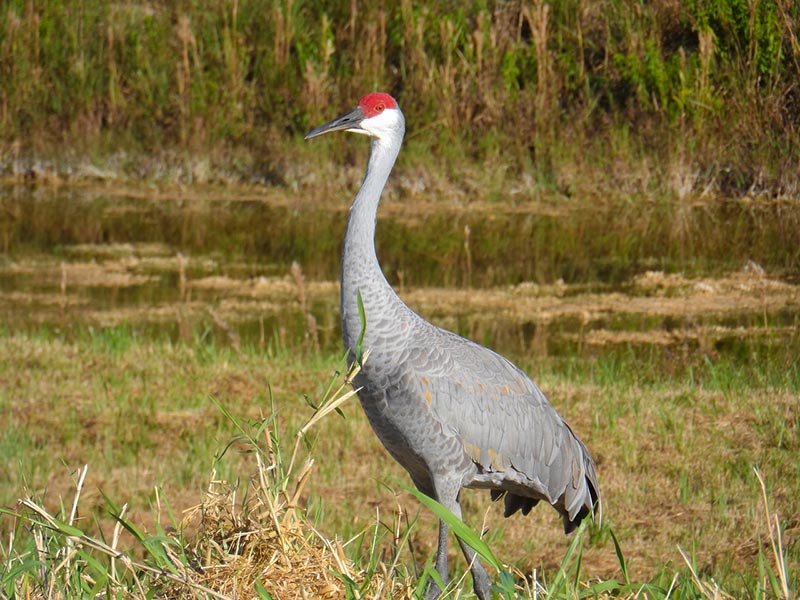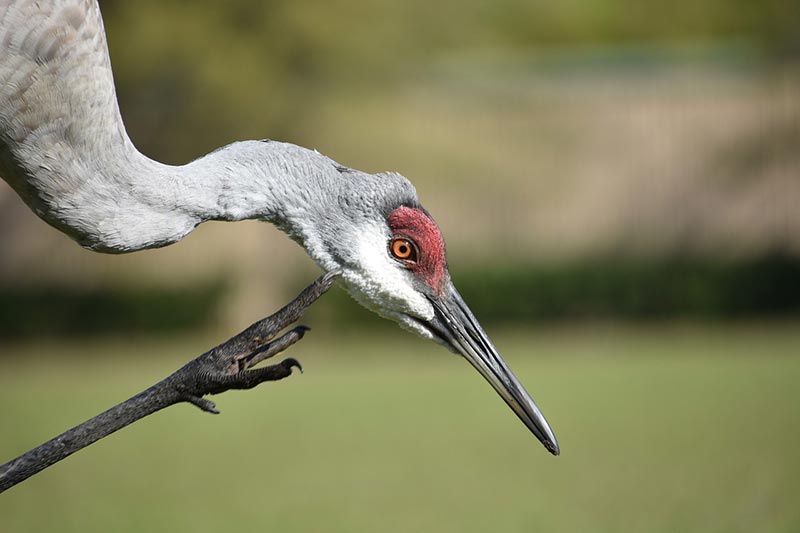Can You Hunt Sandhill Cranes? Everything You Need to Know!
Last Updated on

The main reason why sandhill cranes are always in such high demand is that they guarantee an unforgettable hunting experience, in addition to their top-tier table fare. And that’s something that very few game animals can rival. So, yes, you can hunt them – but there are quite a few caveats.
If you’ve ever wanted to hunt sandhill cranes and are wondering how, read on below to find out more.

Do You Need a License to Hunt Sandhill Cranes?
Before you go out hunting cranes you must talk to the local authorities. Find out if you’ll need a license, permit, certification, endorsement, and any other form of authorization that they deem important.
Most states require all hunters to have a “Federal Duck Stamp,” which is also called the “Migratory Bird Hunting & Conservation Stamp.” It’s an adhesive stamp given to anyone looking to hunt migratory waterfowl species in the United States.
The Federal Sandhill Crane Permit is meant for hunters who are only interested in hunting sandhill cranes, while the Harvest Information Program Certification helps biologists keep track of the birds. Without it, they’ll never be able to figure out the total number of resident birds being harvested every year.
You’ll also need a Migratory Game bird Endorsement. It’s a seal of approval that happens to be a requirement for anyone hunting woodcocks, doves, gallinules, waterfowls, snipes, rails, and coots. To qualify, you must be 17 years or older.

Where Do People Hunt Sandhill Cranes?
Getting an opportunity to hunt sandhill cranes in the United States is not easy. Hunting them used to be illegal (and still is in some states) because their populations were drastically decreasing. But your odds of getting access to hunting grounds in the southern parts of the country are better than anywhere else.
As a matter of fact, Alabama had its first sandhill crane hunting season 2 years ago—the first in over a century. If that’s not a testament that their populations have exponentially grown, we don’t know what is.
Very few states have an open sandhill hunting season. The most notable ones are Texas, Wyoming, South Dakota, Oklahoma, Utah, Colorado, Kentucky, and Kansas.
Behavioral Traits of The Sandhill Crane
These birds are opportunistic feeders. By that we mean, they’ll eat anything available in order to survive. We’re talking about seeds, grains, plants, meat, fruits, you name them.
They also mate for life. The only thing that can break a bond between a breeding pair is death.
At the beginning of spring, while the mates are preparing to migrate to their breeding sites, the single sandhills will be busy looking for compatible mates. These cranes are vocal but you’ll only be able to hear their loudest calls during this season. Both the males and females will release different calls to signify the formation of a bond.
You’ll be able to tell the cranes are about to mate by just looking at their movements. Even though they mostly dance during the breeding season, it’s also an observable trait during mating. They’ll throw plants and sticks into the air, jump for a little while, bow several times, and then wildly flap their wings.
Most of their breeding grounds are in the northern regions. They’ll start mating from the minute they arrive and then build the nests. This species prefers to build its nest on the ground, using plants as construction material. The female will lay a maximum of two eggs and take care of them while the male stands guard.
After 4 weeks the eggs will hatch and the younglings will be ready to explore the world after 8 weeks. In the fall, you’ll see the breeding pair move back to the southern region, with their juveniles not far behind. It will take close to 2 years for the juveniles to mature sexually and start searching for a mate.
They have an average lifespan of 20 years, but because the wild is a dangerous place, very few of them make it to the twentieth year.


Sandhill Crane Hunting Tips
1. Never Let Them Spot You
This right here is the most important tip of them all—and we cannot stress this enough. The minute the crane sees you, nothing you do will change your fortunes. This species has a vision comparable to that of a wild turkey. Those who’ve hunted wild turkeys before will tell you how incredible their vision is.
Take advantage of the natural cover. 2 or 3 days before the hunt, scout the territory, and look for willow branches that you’ll use to hide your gear and all of you. On the day of the hunt, show up very early in the morning, and cover yourself. Don’t forget to get as low as you can, and stay there—no unnecessary movements, or you’ll spook the prey.
Also, the goal of staying low is to ensure all your unnatural outlines aren’t visible to any animal. Not just the crane.
2. Shot Placement
Any experienced waterfowl hunter knows just how important shot placement is. And it’s among the first things that they tell you, should you ask for advice. What they might not emphasize is, that a sandhill crane hunt requires intense focus. Because when you’re out there, you won’t just be shooting a bird that’s flying in a different direction.
That pterodactyl-looking species will be coming right at you. In theory, seeing as it’s not a small bird, you’ll have a large surface area to shoot.
However, this world has silent rules that must be followed. You’re not allowed to shoot the legs, wings, or chest. You must relax, take deep breaths, find the beak, and then pull the trigger. Shooting any other part is considered inhumane.

3. Calling
Cranes are one of the most vocal species in the wild. That’s what makes calling crucial. But if you’ve decided to call, don’t oversell it. A good hunter knows when to call, and when not to.
Observe the bird’s behavior, and gauge whether you’ve caught its attention. If they start flying in your direction, that’s a sign they’re already committed. So, from there on out, the calls will more or less sound like red flags.
It will take some learning to know what mistakes to avoid. Perfecting the quality of the call requires a lot of dedication and patience.
4. Ghillie Blanket & Backboard
Comfort is so important when you go out for these types of hunts. We’ve been told it’s virtually impossible to keep a low profile, without a ghillie blanket and a backboard. Or how else are you going to be dry and warm?
Making sure that the ghillie stays concealed is not that difficult. Just use the same natural hide that you were going to cover yourself with. But don’t use too much of it, though. You’ll end up creating a conspicuous space, and the crane will know something’s up.
Bird species that migrate annually do have a very good memory. It’s the one thing that helps them remember where all the water holes are, in case they need to hydrate and get food. The sandhill crane is a migratory bird. For that reason, if it smells something fishy in that area, it won’t ever come back.

5. Decoy Spread
We’re certain that your goose-decoy-spread configurations have produced incredible results over the years. But that being said, let’s not forget the fact that cranes are in a different league. Whatever you apply here should be one of a kind.
For starters, with the crane-decoy spread, all hunters are supposed to be at least 20 yards away from the decoy. And try to remember to keep your eyes away from their positions.
The other important thing to note is the “slip” factor. This species usually glides perpendicularly to the wind or “slips” as it approaches the spread. Therefore, for it to successfully land, it will need a long stretch of runway to glide or slip into. If the spread doesn’t provide sufficient runway, they’ll never commit to it.

Final Word
We would like to finish by letting you know two of the sandhill crane’s subspecies are still listed as endangered. They are the Cuban sandhill crane and the Mississippi sandhill crane. According to the National Wildlife Federation, we’ve contributed significantly to their habitat loss. So even if you have a permit, it’s still illegal to hunt, tag, or trap those two subspecies.
Featured Image Credit: JodyDellDavis, Pixabay
About the Author Robert Sparks
Robert’s obsession with all things optical started early in life, when his optician father would bring home prototypes for Robert to play with. Nowadays, Robert is dedicated to helping others find the right optics for their needs. His hobbies include astronomy, astrophysics, and model building. Originally from Newark, NJ, he resides in Santa Fe, New Mexico, where the nighttime skies are filled with glittering stars.
Related Articles:
Can You Use Binoculars to Look At Stars? How to Choose the Right Pair
10 Types of Hummingbirds in Arkansas (With Pictures)
8 Types of Hummingbirds in Nebraska (With Pictures)
5 Types of Hummingbirds in Idaho (With Pictures)
3 Types of Hummingbirds in Mississippi (With Pictures)
8 Types of Hummingbirds in Kansas (With Pictures)
5 Types of Hummingbirds in West Virginia (With Pictures)
5 Types of Hummingbirds in Ohio (With Pictures)
